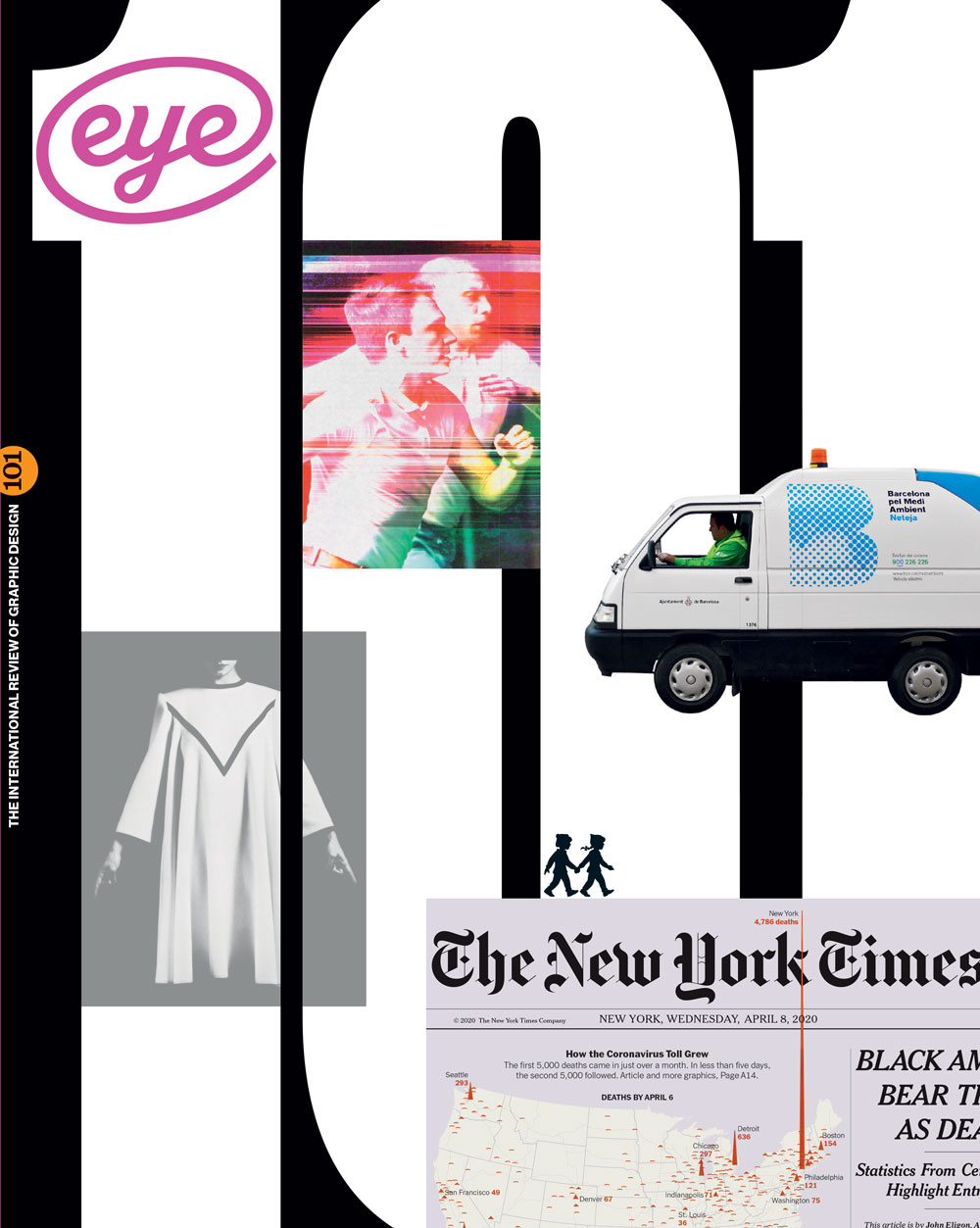Summer 2021
Ten projects by Jim Sutherland
A graphic designer downsizes to spend more time thinking, studying and designing without commercial studio pressures. What could possibly go right? By Simon Esterson. Portrait by Philip Sayer

For Jim Sutherland, design projects are all about ideas. There is no signature style applied across his work; no obsession with a group of typefaces. Instead, each project has at its core an idea that determines its visual direction. The identity for the Kings Place music centre is based on the sound waves generated by different pieces of music; the stamps celebrating crime writer Agatha Christie are full of clues to be discovered; in his marque for Start-rite the ‘R’ letters sport pairs of shoes.
It is no coincidence that in 1988 Sutherland’s first job after leaving Norwich School of Art was at The Partners, the 1980s masters of graphic design as witty idea and the agency that coined the term for this whole design category: ‘the smile in the mind’.
‘I’m not sure I can explain how naive and shy I was when I left college,’ says Sutherland. ‘But I loved designing stuff and I loved coming up with ideas for things. I had gone straight from school and didn’t do a foundation. I went to Norwich to do illustration. Got there, realised everybody could draw better than me and switched to graphics. In 1988, at the end of the course, Ray Gregory, my tutor said: “Where are you going to work? Go to the library and find the D&AD Annual and look up some companies.” That year The Partners had 22 pieces of work in the annual. I said: “I want to work at The Partners.”’
He got an interview. ‘I was in my £3 suit from Oxfam. Dad had told me to wear a suit and a tie. Nick Wurr (one of the agency’s founders) went through my folder. It was very Norwich, full of ideas. Nick said: “Well Jim. This is one of the worst typographic folders I’ve ever seen.” But then he said: “There are so many ideas in here … you can learn everything else.” Sutherland was at The Partners for six years and then moved to Halpin Grey Vermeir, where he became creative director, for seven.
Sutherland’s next move, in 2001, was to co-found Hat-trick with fellow creative directors Gareth Howat and David Kimpton, both ex-Partners. For thirteen years, Hat-trick produced consistently award-winning work for mainstream clients such as the Royal Mail, property group Land Securities and the Natural History Museum. Then in 2014 Sutherland decided to leave.
‘It got to a point when I was spending more time managing people than designing. Fifteen people. Three partners. For me, the joy had gone out of it. I thought “I’ll have a sabbatical” … then I thought “I’ll have a sabbatical and not go back.” Then I realised, that’s leaving. So I left. We had some lovely projects and a really good team, but I needed a break from doing this. The plan was to have six months off. That lasted about a week. I turned my lounge at home into my studio and started doing projects without any commercial pressures.’ Studio Sutherl& was born.
Busy mind, clear table
I’m sitting with Jim Sutherland in his bright, new studio in South London, in a time between the UK’s various Covid-19 lockdowns. There are two big rooms. One for working (tidy piles for each project, ideas on the walls, books) and one for meetings (huge clear table, images from past projects on one wall). He might have moved the studio out of his house, but in six years as Studio Sutherl& Jim has tackled a wide range of projects while staying small and working with one other designer in the studio. That is how he plans to keep it.
‘I really enjoy having someone around, but without the responsibility for a team,’ he says. ‘The freedom has been amazing and my mental health and the work has all got better. Alice Tosey stayed for two and a half years, and then Rosey Trickett joined in 2017. She comes in four days a week and works one day from home. Rosey is a designer, not an assistant. There’s a bit less pressure in a small studio, but I think most of that pressure is in your head anyway. We’ve got twenty-odd projects on at the moment: that’s crazy for two people. Which is partly why I have this clear desk thing. It looks calm, even though in my head it might not always be.
‘I don’t really look for new business in terms of approaching people. New work comes through recommendations from people we have worked with before or design strategists like Jane Wentworth and Jo Marsh. For me, “new business” is doing the work you’ve got in front of you really well. The chances are that people will recommend you to someone else.
‘I just want to produce lots and lots of stuff. The realisation – once you set up on your own – is that you can do whatever you like as long as you can work out a way of sustaining it. It’s your life.’
Thinking and doing
What fuels the ideas engine? Sutherland surrounds himself with books, goes to exhibitions and talks, captures images and thoughts. And of course he is busy on social media.
‘Now I’ve got time to look around,’ says Sutherland. ‘I feel that since I left Hat-trick I’m almost doing my own design MA. It’s been a revelation to me of all the things that are out there to imbibe.
‘I want to be in the city. I want to go to galleries. Having the time on a Thursday afternoon to explore, it’s not like you’ve got to be sitting at your desk all the time. I cycle round town: you get to Westminster Bridge and I just look around and I’m stunned, I haven’t got over that childlike sense of living in this place with all these things going on. Giving talks and workshops with students is rewarding, too. It feeds into the work and makes me think about what we’re doing.
‘Notebooks to me are key. The ones from Hat-trick days were lists of things to do. Since I’ve left, they’ve got far more drawings and thoughts and bits out of books in them. They’ve become much richer. When I do student talks I use them to show the process … they’re a working tool. And they get me away from the computer.
‘I’m really keen to meet and get involved with clients’ in-house designers, like the Start-rite team [which Sutherland worked with from 2014-19, see opposite]. There are a lot of really good people in-house and they can be slightly brow-beaten. Working with an outside designer can give the in-house team a lot of confidence, and you can elevate their standing in the organisation.
‘We’ll do the first bit, but they’re going to be the ones who will do the work. I won’t do any projects unless I can speak to the person who is actually in charge and the person who is going to be doing it day-to-day. That’s been quite a learning process … of realising I’ve not got to do all this myself.
‘I design everything, including personal things. If you have kids, you design their birth announcements. It’s a mental exercise. It’s like a gym. You keep designing stuff and you get better at it.’
1. Start-rite shoes, 2017. Designers: Alice Tosey, Rosey Trickett. Strategy: Jo Graham Consulting. Lettering: Roger Taylor, Jeremy Tankard. Photography: Fiona Burrage. Illustration: Rebecca Sutherland.
Top. Portrait by Philip Sayer.

In the 1930s, British children’s shoe brand Start-rite created a now iconic poster of a young boy and girl, ‘the twins’, starting out down a long and metaphorical straight road. But by 2014 the brand had lost its way.
‘Start-rite is one of the most famous children’s shoe companies in the world,’ says Sutherland. ‘They approached me through a strategy company that was looking at the brand’s future. It was probably the first really big project I got on my own. It was relatively well paid, and I got to do what I wanted typographically. It was a competitive pitch. I was really honest, I said we’re a small studio and I’m not going to free pitch. I turned up to this industrial estate outside Norwich in the pouring rain. I didn’t show them any creative work. We just had a chat.
‘The famous 1930s twins mark (1950s poster above left) had been bastardised over time … the figures had been outlined in one colour … the road had been removed so the perspective was wrong. It was an open brief that asked: “Should we keep the twins? The reproduction is terrible. They don’t appeal to older kids.”
‘But you don’t throw these things away lightly. We [Jim’s wife is illustrator Rebecca Sutherland] redrew the twins as silhouettes so they were much clearer. The whole thing became about kids exploring and having fun: the twins were “released” so that they could appear anywhere.
‘Then we looked at the typography and realised early on there’s two ‘R’s and just by adding serifs you get the twins’ feet. With those serifs they become little personalities. We created the “typefeet” font.
‘For the launch we had some of the characters made big in 3D. There’s an ampersand that’s just crossed its legs and is relaxing on the sofa. You feel like you’re sitting next to a person.
‘The photography maintains the twins theme: it’s always done with two children running about. The breadth of the job means it became a deeper identity. That direct relationship lasted two-and-a-half years until the CEO was head-hunted to go to another shoe company. Now the in-house team maintain the design.’
2. Agatha Christie stamps, 2016. Client: Royal Mail. Illustrator: Neil Webb. Designer: Alice Tosey.
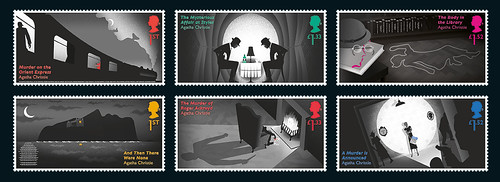
Studio Sutherl& designed a set of stamps for the Royal Mail that celebrated crime writer Agatha Christie through six of her books, with illustrations by Neil Webb. ‘I’ve done over 50 stamps, mainly when I was at Hat-trick, and this was the first project I did when I set up the new studio,’ says Sutherland. ‘I wanted to do something quite 1930s or 40s, like black-and-white film stills with a narrative. I read all of the books for the pitch. The books are darker than the TV adaptations. As I was reading them I did little sketches in the margins of the books. I would send Neil a sketch of a train with smoke that’s in the shape of the detective Poirot’s face and back would come an amazing rough. ‘Among the clues they’ve also got different print techniques hidden in the stamps. One is heat-sensitive, so if you put your finger on it the curtain disappears and the killer is revealed. One uses UV-sensitive ink and the clock face lights up. Another is a Miss Marple “body in the library” mystery, and we printed all the titles on the shelves in 0.1 pt microtext on the book spines. There’s also a suicide note in micro text. On a poison bottle we printed the stamp in miniature. I liked the idea of a detective and a stamp collector both having to use a magnifying glass.
‘Because it’s a set of six stamps we hid the word AGATHA, one letter in each stamp. ‘T’ is on the tea cup … with some projects I don’t know when to stop! These are as much Neil Webb’s stamps as mine. And the Royal Mail’s – they have amazing attention to detail. ‘The whole project was two years in the making. Time helps.’
3. Walworth Garden, 2019. Designer: Rosey Trickett. Strategy: Eleanor Appleby.
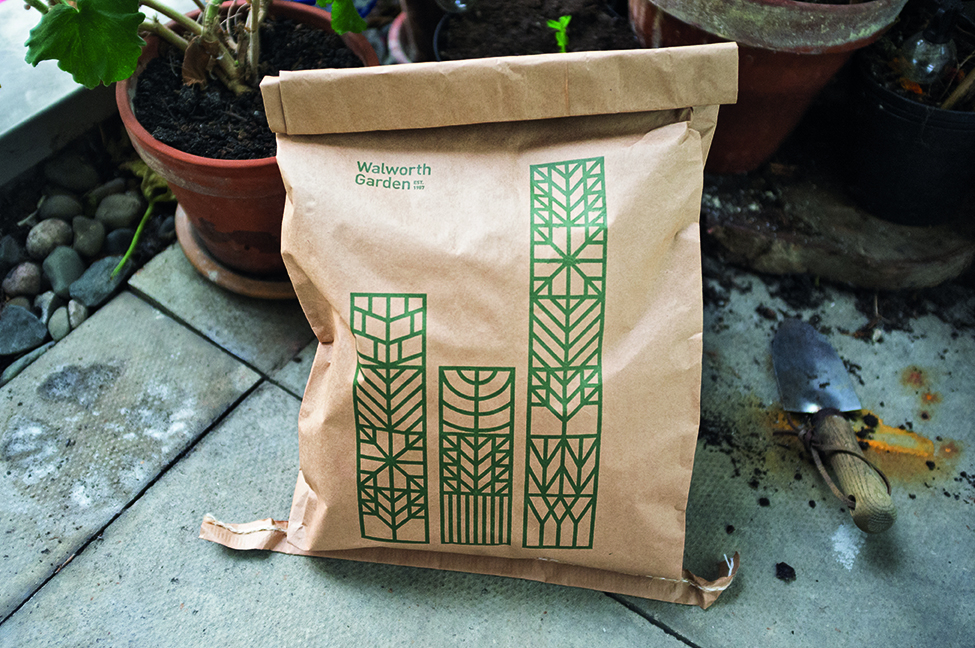
Eleanor Appleby, one of the strategists with whom Studio Sutherl& works, was involved pro bono with Walworth Garden, a local South London charity ‘dedicated to knowledge and nurture’.
Sutherland says: ‘It’s a community garden just round the corner. They do training for the council, helping people that have got into problems. Eleanor did the strategy for the project. The identity is a series of building blocks based on leaf venations (the systems of veins): every plant leaf is based on these nine patterns. We made the sign out of fret-cut aluminium, so it becomes like a trellis that the plants grow through and used wood and rubber stamps to make the plant labels.
‘Another advantage of keeping the studio small is that you can be working on projects like this alongside big ones. There was no fee, but they gave us all the plants for the studio.
‘We show our ideas to clients much earlier now. I’ve got much more open. It’s not been a case of getting older and believing, “Now I’ve got all the answers,” or thinking, “We’re the people who are going to tell everybody what to do” It’s been the opposite.’
4. Garage, 2007. Designer: Jessica Sutherland.
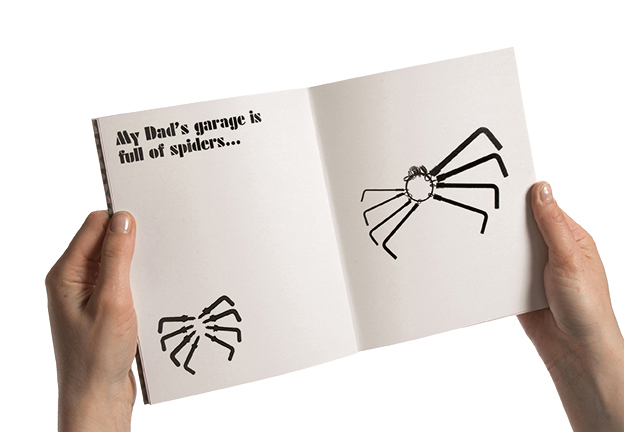
Garage is a small-format book, a personal project made while Sutherland was still with Hat-trick, which brings closely observed objects to life.
‘It is about the contents of my dad’s garage,’ says Sutherland. ‘It started off with my mum saying to me after he died, “Could you tidy up the garage?” I had spent a lot of time over there with him. He was a very practical person, but he wanted to do things properly.
‘I dragged my daughter Jess over to this dusty garage that nobody’s been in for a couple of years. We walked in and the first thing we found was this set of Allen keys. Two of them had been torn off, making an eight-legged spider. I’d been talking to Jess about spiders on the way over. Suddenly we were over there with a lightbox taking pictures of things. Not with the idea of making a book, I just thought this was a nice way of spending a day.
‘I try to convince myself these are not just personal projects … more R&D. They’re mental exercises. The book jacket is made of greaseproof paper, the sort of paper that might protect Stanley knives. We sent the book to all our (Hat-trick) clients and got so many kind letters back. We never finished tidying the garage.’
5. The Human Atlas projects. Artist / Photographer: Marcus Lyon, Photography / Sound: Joe Briggs-Price, Producer: Camila Pastorelli, Maps: Laurent Brindeau, Sound: Rethink Audio, App creation: Calvium, DNA analysis: Family Tree DNA.
Right. Cover of i.Detroit, 2020. Designer Rosey Tricket.
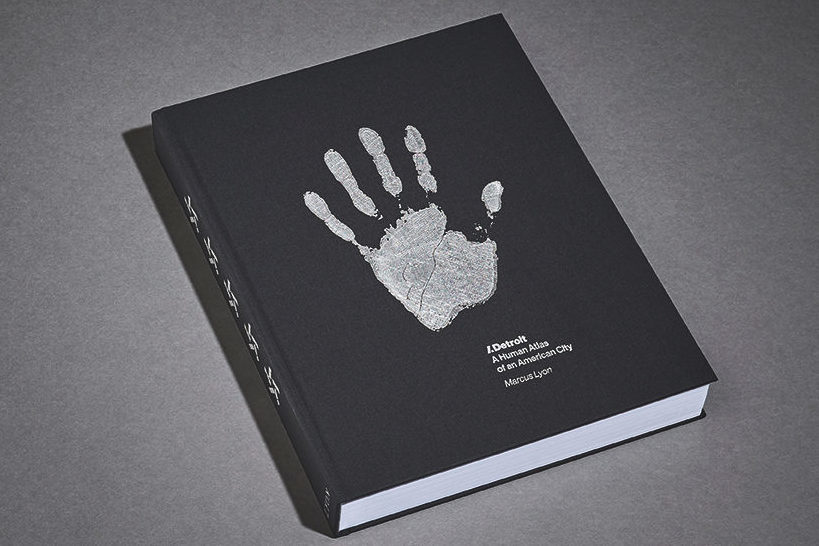
Marcus Lyon, the British artist and photographer, has so far made three books under the series title ‘The Human Atlas’. The first was about the people of Brazil, followed by books about Germany and the city of Detroit. Lyon takes portraits, records interviews and commissions an ancestral DNA analysis of his subjects to tell the complex stories of people’s identity.
Lyon says that the project ‘endeavours to hold a mirror up to society and encourage audiences to question their own roles and responsibilities to their communities, cities and fellow human beings.’
Sutherland travels to the locations to get a sense of place, which then influences each book’s design. In addition, there are exhibitions of the photographs and an app that plays the sound recordings. ‘You can scan the portraits with the app and they literally speak to you as you look into their eyes - it’s completely magical,’ says Sutherland.
The first Human Atlas book, Somos Brasil, was published in 2017, followed by We.Deutschland in 2019. i.Detroit, delayed by the pandemic, was just binding when Sutherland spoke to Eye in August 2020, and was launched in October. Lyon secures money to shoot, design and print the books from local organisations. For i.Detroit the Kresge Foundation have funded a large-format book printed in London by Boss with 100 vivid six-colour portraits and pages of infographics immaculately printed in tints of silver and black.
‘When we started talking about Somos, I said to Marcus “I’ll do it for nothing if you take me to Brazil.” He said “I’ll take you to Brazil and I’ll pay you.”’
Spread from Somos Brasil, 2017. Designer. Alice Tosey.
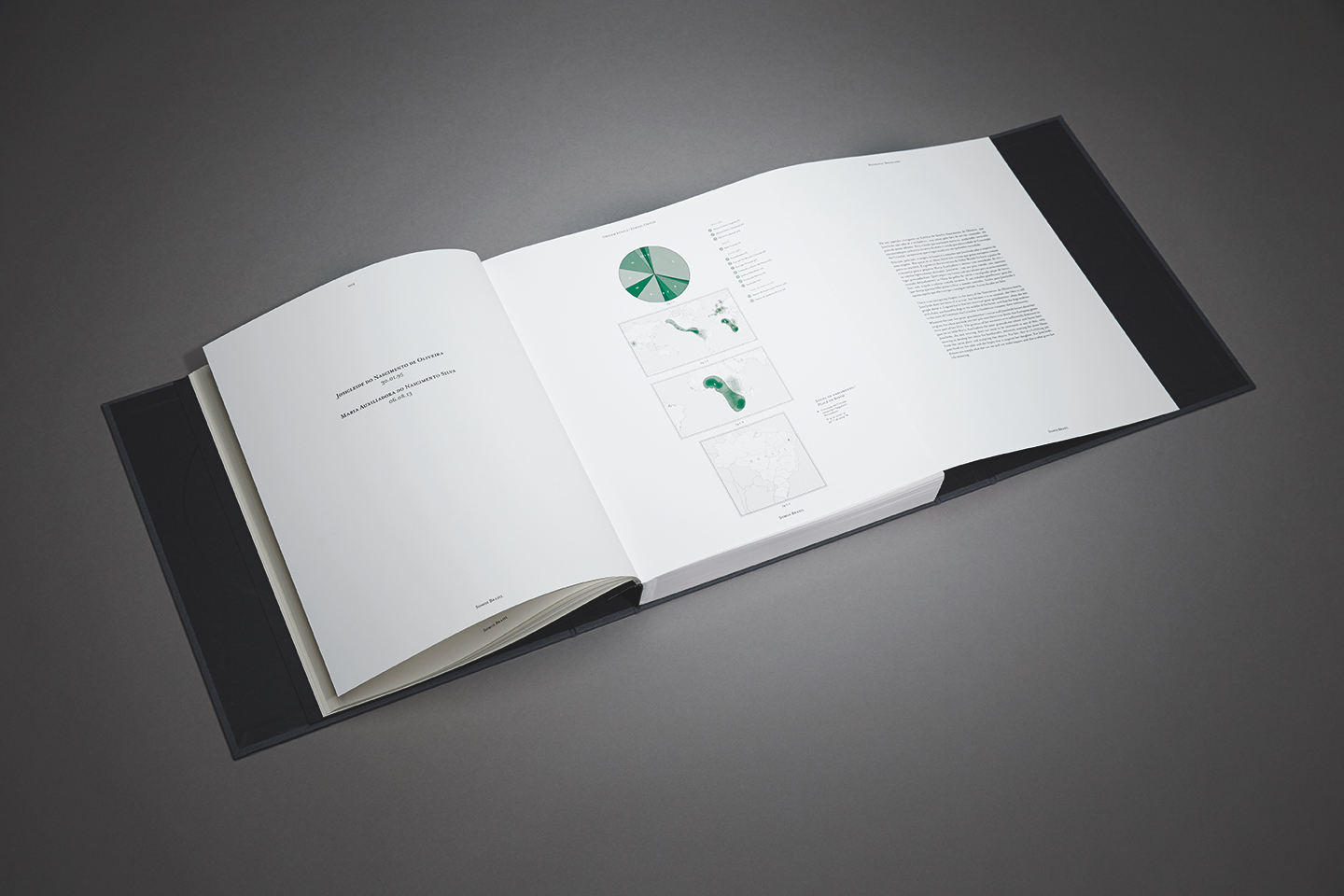
I found this note recently that said: “I wonder if this is the future of the studio?” I like the fact of having an excuse to go somewhere because you’re working on a project.
‘I thought Detroit was a fascinating place. Because of urban decline, it’s suffered from “ruin porn”, with photographers making lurid pictures of its decaying buildings. Everybody there hates that attitude, and this book is a positive view of the city. It’s about people that stayed and people that returned and built something up. i.Detroit has been two and a half years of the studio’s life – 500 pages of maps, photographs of individuals in Detroit and DNA results. I think The Human Atlas is the most nourishing project we’ve done in the studio.
‘Book projects become so personal because you invest so much into them. They’re so multilayered. We did Somos not knowing there was going to be another atlas. These books shouldn’t be uniform, there should be something about the place in each one. Even just in terms of format and colour, using black and silver felt appropriate for Detroit. I liked the Henry Ford quote, “any colour as long as it’s black”, and the silver is quite automotive and industrial.
‘Mapping is key to this edition, Detroit is a gridded city. Music is key, too: we’ve had a seven-inch single pressed to tip in on the inside back cover. Techno music pioneer Derrick May is in the book, and he’s used sounds recorded by Marcus to create one side of the single; Brian Eno did the other. The next atlas is De.Coded, about Silicon Valley, which we’re hoping to shoot in 2021.’
6. Kings Place, 2019. Designer: Rosey Trickett. Strategy: Jo Marsh, Winster Marsh. Software engineer / Digital media artist. Joe Pochciol.

That Studio Sutherl&’s identity system for London arts venue Kings Place takes influence from music is no accident, (writes Mark Sinclair). It is generated by sound itself. Referencing both the curving shape of the Dixon Jones-designed building and the variety of performances, festivals and events it hosts, the venue’s visual identity comes from a strategy conceived by Winster Marsh that positions the space as ‘the cultural pulse of King’s Cross’. The identity has a visual connection to the building’s undulating glass façade (and the water that surrounds it on two sides), while being based on what is produced inside: sound waves.
Kings Place contains a performance hall, a smaller studio and rehearsal space and houses the resident Aurora Orchestra alongside the headquarters of The Orchestra of the Age of Enlightenment and the London Sinfonietta. Acoustic design, key to its construction, is reflected in the kinetic nature of the organisation’s identity, which uses Jonathan Hoefler’s typeface Champion as its starting point.
To bring the identity to life, Sutherl& collaborated with software engineer and digital artist Joe Pochciol to develop a software package called SoundWaveMachine that can generate a new logotype (static or animated as required) from a single sound file.
‘We can vary the amplitude, gain and modulation,’ explains Sutherland. ‘We can also use the waves themselves graphically, for building manifestations and in print.’ The software enables Kings Place to experiment with the system and produce the logo in-house, including bespoke iterations relevant to a particular artist or performance. The organisation’s sub-brands can also work from appropriate music tracks to generate new versions of the identity in the same way. Graphic design studio Binomi is managing the roll-out of the work with Studio Sutherl&.
A pleasing coda to the project is the use of the design on business cards and email signatures for Kings Place staff that feature versions of the identity based on their chosen pieces of music. For Sutherland, part of the pleasure
of seeing the identity in use has been witnessing the unexpected designs the software creates.
Like much of the music performed at Kings Place the identity project may have its roots in more standard structures and systems, but its brilliance lies in how it can also free itself to become an engaging experiment in tone, shape and form.
7. Eeormoo?, 2016. Designers: Kelvyn Laurence Smith, Alice Tosey. Writer: Jim Sutherland. Illustrator: Rebecca Sutherland.
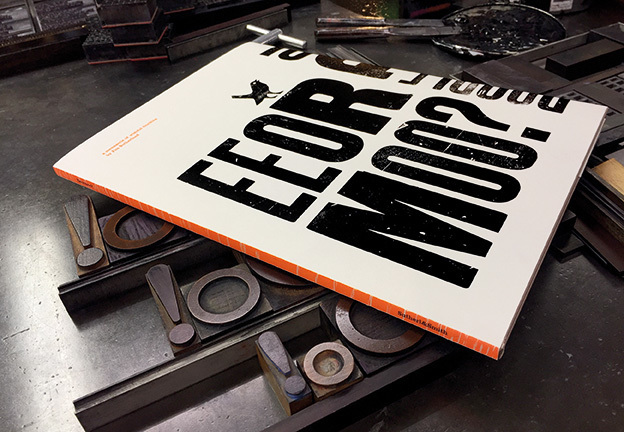
Jim Sutherland often makes projects with letterpress printer Kelvyn Smith (also known as Mr Smith).
‘We both went to college together but I didn’t really know him, then,’ says Sutherland. ‘Then I did a workshop with Alan Kitching (see Eye 74) in 1992, when Kelvyn was Alan’s assistant.
‘Later, Kelvyn set up his press and workshop in Kennington, near where I’d moved, and I’ve been going round there ever since.
‘We did a few joint prints as Sutherl&Smith, and then I started Eeormoo?, a kid’s book about animals making the wrong noises. My wife Becky drew the characters and we had them made into printing blocks. We used Kelvyn’s wood type, set my poems in metal type, printed it letterpress and scanned the result so that Boss could print a litho limited edition. David Stuart, my first boss at The Partners, wrote to me saying: “The imperfection of the type goes well with the imperfection of the writing.”
‘It’s not done to make money. It’s lovely to create and it gives you an excuse to send something interesting
to people.’
8. Perspectiva, 2021. Designer: Rosey Trickett.

Any project that involves the game of chess gets Jim Sutherland’s attention. ‘I was recommended to [philosopher] Jonathan Rowson, who is a former chess Grandmaster. He and another philosopher are setting up a global think tank, Perspectiva, to look at the world’s problems in a different way.’ Perspectiva says it aims to ‘cultivate the imaginative and emotional capacity required to usher in a world that is technologically wise and ecologically sound.’
‘There’s a website and they’re going to publish pamphlets and books,’ says Sutherland. ‘Jonathan wrote a book The Moves That Matter about things he learnt from playing chess applied to life: it’s written in 64 sections. I tried to explain I’m not very good at chess, but I like the graphic language of it. I love playing chess. I love the focus. We’ve done an identity for Perspectiva which uses a grid of multiple perspectives: it’s a very rational interpretation of the name. It’s based on a series of invisible cubes. This is about working with someone who is doing something really interesting.’
9. St Albans Museum + Gallery, 2019. Designer: Rosey Trickett. Strategy: Jane Wentworth Associates. Exhibition Design: Mowat & Co.
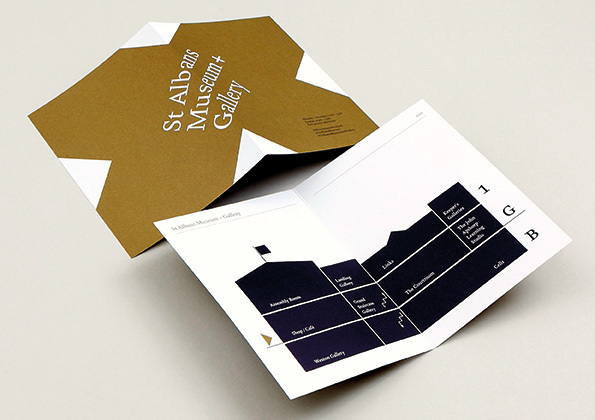
The St Albans Museum + Gallery identity is for a Georgian building that was converted from town hall to museum for the local council. Sutherland explains: ‘They have a St Alban’s cross, like a saltire, so we used the negative spaces, the triangles, to create patterns. There isn’t a single mark. We also used the triangles for arrows in the signage.
‘What’s interesting now is that you can do these complex projects and the team doesn’t have to be permanent. When we won the pitch for St Albans, we worked closely with the exhibition designers Mowat & Co. and the architects McAslan and we all became part of the team working on that building. We did the identity, helped to design the exhibition displays and designed all the merchandise in the shop. It was an all-encompassing project.
‘I think that’s what’s lovely at the moment. You can set up these mini-groups for one project and then separate again.’
10. Boxes in boxes, 2017. Designer: Alice Tosey. Printer: Fenton Smith.
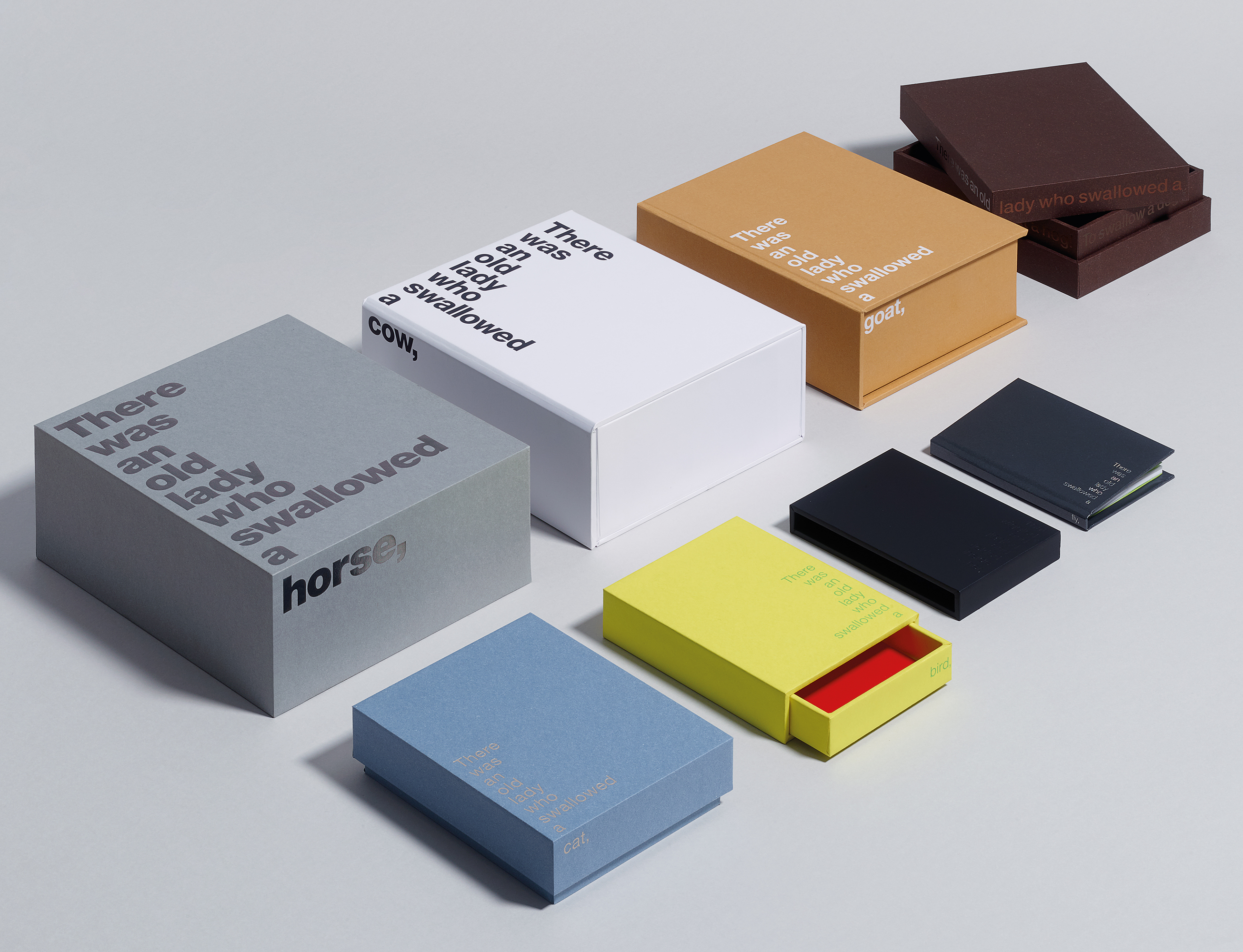
A frequent Studio Sutherl& collaborator is Fenton Smith, who runs the London-based printer Boss. Smith wanted to show his factory’s boxmaking capabilities.
This series of seven differently constructed and finished boxes within boxes is linked by a children’s nonsense rhyme – ‘There was an old lady who swallowed a fly’ – whose protagonist swallows increasingly large creatures.
The precisely positioned sans serif typography contrasts with the absurdity of the cumulative verse.
‘This project just came along,’ says Sutherland. ‘Fenton said: “I’m thinking of doing this.” No money changed hands; it was a nice project to do with someone who wanted to do something interesting. Narrative defined it. I positioned the type to help you understand the design characteristics of each box.
‘I hate these graphic design camps. It’s a shame there’s a perception that it’s either “smile in the mind” or an interpretation of that certain period of Swiss design, and it’s discussed like you can’t have anything else. For me, the best work around is where you don’t even need to have that discussion. The fact that “smile in the mind” is now seen as some sort of insult … as is the declaration “that just looks like a lot of Swiss stuff”. It’s not either / or.
‘As designers, we have the ability (and duty) to communicate beautifully but also bring some joy to the audience regardless of design style or dogma.’
Simon Esterson, art director of Eye, London
First published in Eye no. 101 vol. 26, 2021
Eye is the world’s most beautiful and collectable graphic design journal, published for professional designers, students and anyone interested in critical, informed writing about graphic design and visual culture. It is available from all good design bookshops and online at the Eye shop, where you can buy subscriptions and single issues.

